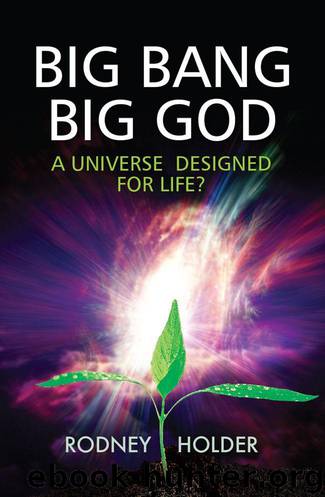Big Bang Big God: A Universe Designed for Life? by Rodney Holder & John Polkinghorne

Author:Rodney Holder & John Polkinghorne
Language: eng
Format: mobi, epub
Tags: Religion, Religion & Science
ISBN: 9780745956268
Publisher: Lion Books
Published: 2013-10-18T04:00:00+00:00
7
OF THE MAKING OF MANY UNIVERSES THERE IS NO END
Do there exist many worlds, or is there but a single world? This is one of the most noble and exalted questions in the study of Nature.
St Albertus Magnus (c. AD 1260)1
Universe or Multiverse? A Brief History of Recent Cosmology
In the search for the “ultimate theory of physics” physicists and cosmologists are driven by two considerations. The first is the specialness of the way the Big Bang and the laws of nature seem to be set up so that life can come into existence in the universe, as we discussed in Chapter 5. The second is the need in any case for a more fundamental theory to describe the physics at the earliest epochs in the universe’s history and, purely from the point of view of physics, to combine the four fundamental forces into one. It is interesting to trace how over the last half century or so cosmologists have oscillated between single universe and multiverse theories. In the terminology of the last chapter, they can be said to have alternated between strategies (1) and (2), though not always with atheistic motives.
Chaotic cosmology
We begin this brief survey back in the late 1960s when the cosmologist Charles Misner came up with the “chaotic cosmology” programme, which sought to show that the initial conditions at the Big Bang didn’t matter.2 More or less any initial conditions would lead to a smooth universe such as we observe today. This is what Ernan McMullin dubbed “the indifference principle” in cosmology.3 However, this idea was demolished by Stephen Hawking and a colleague of his, Barry Collins, in a paper written in 1973.4 In order to give rise to life the universe must quickly approach a state in which it looks the same in all directions (technically it is “isotropic”). If that is not the case, then large-scale irregularities will make it impossible for galaxies and stars to form. Collins and Hawking showed that the probability of a universe like ours emerging from the Big Bang – looking the same in all directions in the sky to a high degree of accuracy – is actually zero.5 You cannot have greater precision in the way the universe is set up than that.
Collins and Hawking turned to a multiverse (strategy (2)) to solve that problem. There are several ways of conceiving a multiverse. The simplest, and the one on which I shall concentrate, is as an infinite space in which there are enormously large regions, each region having its own set of parameters, although, as we shall see, there are several ways in which this version alone may be realized.
Oscillating universes
A second way of getting a multiverse is through successive expansions and contractions of a single universe, an idea associated with the physicist John Wheeler.6 Wheeler speculated that the constants of nature and initial conditions might be randomly reselected at each “bounce”, thus ensuring that at least one bounce gave the right conditions for life.
Wheeler’s idea is fraught with problems.
Download
Big Bang Big God: A Universe Designed for Life? by Rodney Holder & John Polkinghorne.epub
This site does not store any files on its server. We only index and link to content provided by other sites. Please contact the content providers to delete copyright contents if any and email us, we'll remove relevant links or contents immediately.
| Aeronautics & Astronautics | Astronomy |
| Astrophysics & Space Science | Comets, Meteors & Asteroids |
| Cosmology | Mars |
| Solar System | Star-Gazing |
| Telescopes | UFOs |
Tools of Titans by Timothy Ferriss(8162)
Turbulence by E. J. Noyes(7901)
Secrets of Antigravity Propulsion: Tesla, UFOs, and Classified Aerospace Technology by Ph.D. Paul A. Laviolette(5244)
Astrophysics for People in a Hurry by Neil DeGrasse Tyson(5099)
Room 212 by Kate Stewart(4968)
Design of Trajectory Optimization Approach for Space Maneuver Vehicle Skip Entry Problems by Runqi Chai & Al Savvaris & Antonios Tsourdos & Senchun Chai(4962)
Pale Blue Dot by Carl Sagan(4865)
The David Icke Guide to the Global Conspiracy (and how to end it) by David Icke(4563)
A Journey Through Divination and Astronomy by Publishing Pottermore(4325)
Goodbye Paradise(3672)
Apollo 8 by Jeffrey Kluger(3607)
COSMOS by Carl Sagan(3518)
Losing the Nobel Prize by Brian Keating(3479)
The Five People You Meet in Heaven by Mitch Albom(3440)
How to Read Water: Clues and Patterns from Puddles to the Sea (Natural Navigation) by Tristan Gooley(3376)
Brief Answers to the Big Questions by Stephen Hawking(3320)
How to Read Nature by Tristan Gooley(3217)
The Order of Time by Carlo Rovelli(3101)
A Brief History of Time by Stephen Hawking(2918)
